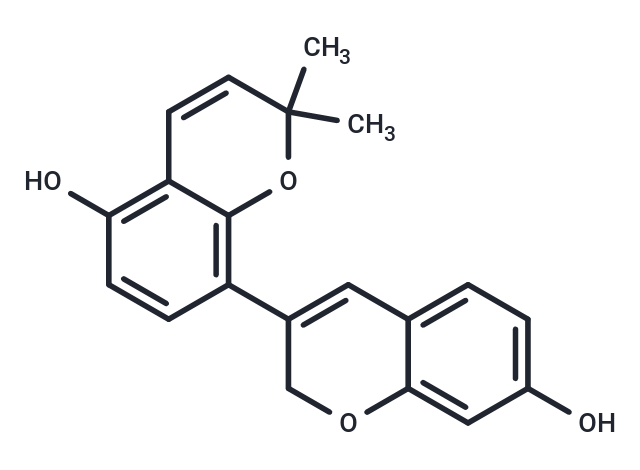- Remove All
 Your shopping cart is currently empty
Your shopping cart is currently empty
Shopping Cart
Glabrene
Catalog No. TN1690Cas No. 60008-03-9
Glabrene, Liquiritin apioside, neolicuroside, and 18α2-glycyrrhetic acid are the predominant phenolic derivatives partitioning at the interface and most likely the major contributors to the notable synergistic antioxidant activity when coupled with pea protein hydrolysates (PPHs).Glabrene has estrogen-like activity, it can stimulate DNA synthesis in human endothelial cells (ECV-304; E304) and has a bi-phasic effect on proliferation of human vascular smooth muscle cells (VSMC). Glabrene and isoliquiritigenin may serve as candidates for skin-lightening agents, they exert varying degrees of inhibition on tyrosinase-dependent melanin biosynthesis.

Glabrene
Catalog No. TN1690Cas No. 60008-03-9
Glabrene, Liquiritin apioside, neolicuroside, and 18α2-glycyrrhetic acid are the predominant phenolic derivatives partitioning at the interface and most likely the major contributors to the notable synergistic antioxidant activity when coupled with pea protein hydrolysates (PPHs).Glabrene has estrogen-like activity, it can stimulate DNA synthesis in human endothelial cells (ECV-304; E304) and has a bi-phasic effect on proliferation of human vascular smooth muscle cells (VSMC). Glabrene and isoliquiritigenin may serve as candidates for skin-lightening agents, they exert varying degrees of inhibition on tyrosinase-dependent melanin biosynthesis.
| Pack Size | Price | Availability | Quantity |
|---|---|---|---|
| 1 mg | $829 | Backorder |
Bulk & Custom
Add to Cart
Questions
View MoreContact us for more batch information
Resource Download
Product Introduction
Bioactivity
Chemical Properties
| Description | Glabrene, Liquiritin apioside, neolicuroside, and 18α²-glycyrrhetic acid are the predominant phenolic derivatives partitioning at the interface and most likely the major contributors to the notable synergistic antioxidant activity when coupled with pea pr |
| Targets&IC50 | Tyrosinase:3.5 μM (IC50) |
| In vitro | The inhibitory effect of licorice extract on tyrosinase activity was higher than that expected from the level of glabridin in the extract. This led us to test for other components that may contribute to this strong inhibitory activity. Results indicated that Glabrene and isoliquiritigenin (2',4',4-trihydroxychalcone) in the licorice extract can inhibit both mono- and diphenolase tyrosinase activities. The IC(50) values for Glabrene and isoliquiritigenin were 3.5 and 8.1 microM, respectively, when tyrosine was used as substrate. The effects of Glabrene and isoliquiritigenin on tyrosinase activity were dose-dependent and correlated to their ability to inhibit melanin formation in melanocytes. |
| Molecular Weight | 322.36 |
| Formula | C20H18O4 |
| Cas No. | 60008-03-9 |
| Relative Density. | 1.293g/cm3 |
Storage & Solubility Information
| Storage | Powder: -20°C for 3 years | In solvent: -80°C for 1 year | Shipping with blue ice. |
Calculator
In Vivo Formulation Calculator (Clear solution)
Please enter your animal experiment information in the following box and click Calculate to obtain the mother liquor preparation method and in vivo formula preparation method:
Mother liquor preparation method: 2 mg of drug dissolved in 50 μL DMSO (mother liquor concentration of 40 mg/mL), if you need to configure a concentration that exceeds the solubility of the product, please contact us first.
(mother liquor concentration of 40 mg/mL), if you need to configure a concentration that exceeds the solubility of the product, please contact us first.
Preparation method for in vivo formula: Take 50 μL DMSO main solution, add 300 μLPEG300
main solution, add 300 μLPEG300 mix well and clarify, then add 50 more μL Tween 80, mix well and clarify, then add 600 more μLddH2O
mix well and clarify, then add 50 more μL Tween 80, mix well and clarify, then add 600 more μLddH2O mix well and clarify
mix well and clarify
For Reference Only. Please develop an appropriate dissolution method based on your laboratory animals and route of administration.
Dose Conversion
You can also refer to dose conversion for different animals. More Dose Conversion
Tech Support
Please see Inhibitor Handling Instructions for more frequently ask questions. Topics include: how to prepare stock solutions, how to store products, and cautions on cell-based assays & animal experiments, etc
Keywords
Related Tags: buy Glabrene | purchase Glabrene | Glabrene cost | order Glabrene | Glabrene chemical structure | Glabrene in vitro | Glabrene formula | Glabrene molecular weight

Copyright © 2015-2025 TargetMol Chemicals Inc. All Rights Reserved.




